二冲程与四冲程发动机相比较
- 格式:doc
- 大小:20.50 KB
- 文档页数:1
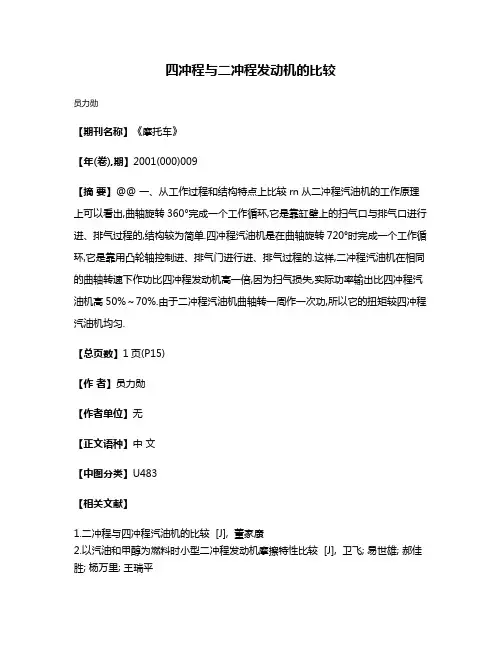
四冲程与二冲程发动机的比较
员力勋
【期刊名称】《摩托车》
【年(卷),期】2001(000)009
【摘要】@@ 一、从工作过程和结构特点上比较rn从二冲程汽油机的工作原理上可以看出,曲轴旋转360°完成一个工作循环,它是靠缸壁上的扫气口与排气口进行进、排气过程的,结构较为简单.四冲程汽油机是在曲轴旋转720°时完成一个工作循环,它是靠用凸轮轴控制进、排气门进行进、排气过程的.这样,二冲程汽油机在相同的曲轴转速下作功比四冲程发动机高一倍,因为扫气损失,实际功率输出比四冲程汽油机高50%~70%.由于二冲程汽油机曲轴转一周作一次功,所以它的扭矩较四冲程汽油机均匀.
【总页数】1页(P15)
【作者】员力勋
【作者单位】无
【正文语种】中文
【中图分类】U483
【相关文献】
1.二冲程与四冲程汽油机的比较 [J], 董家康
2.以汽油和甲醇为燃料时小型二冲程发动机摩擦特性比较 [J], 卫飞; 易世雄; 郝佳胜; 杨万里; 王瑞平
3.二冲程发动机气缸珩磨工艺探讨 [J], 李嘉俊
4.小型二冲程发动机气缸磨耗对活塞表面状况的影响分析 [J], 钟赛君;张擎鸣;王强胜;肖阳
5.为二冲程发动机提供更大的气缸润滑灵活性 [J],
因版权原因,仅展示原文概要,查看原文内容请购买。
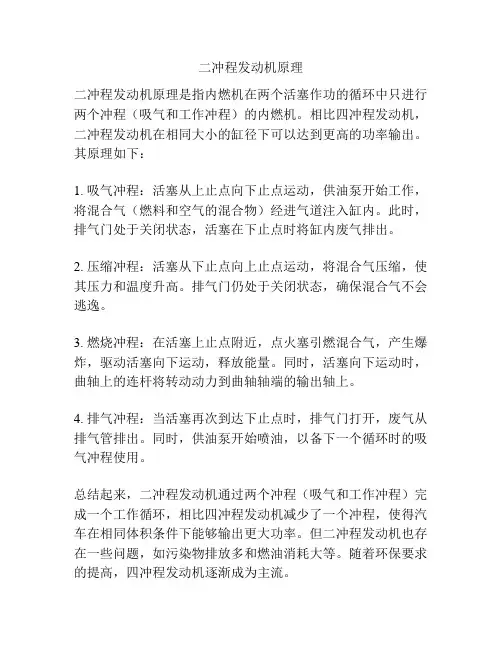
二冲程发动机原理
二冲程发动机原理是指内燃机在两个活塞作功的循环中只进行两个冲程(吸气和工作冲程)的内燃机。
相比四冲程发动机,二冲程发动机在相同大小的缸径下可以达到更高的功率输出。
其原理如下:
1. 吸气冲程:活塞从上止点向下止点运动,供油泵开始工作,将混合气(燃料和空气的混合物)经进气道注入缸内。
此时,排气门处于关闭状态,活塞在下止点时将缸内废气排出。
2. 压缩冲程:活塞从下止点向上止点运动,将混合气压缩,使其压力和温度升高。
排气门仍处于关闭状态,确保混合气不会逃逸。
3. 燃烧冲程:在活塞上止点附近,点火塞引燃混合气,产生爆炸,驱动活塞向下运动,释放能量。
同时,活塞向下运动时,曲轴上的连杆将转动动力到曲轴轴端的输出轴上。
4. 排气冲程:当活塞再次到达下止点时,排气门打开,废气从排气管排出。
同时,供油泵开始喷油,以备下一个循环时的吸气冲程使用。
总结起来,二冲程发动机通过两个冲程(吸气和工作冲程)完成一个工作循环,相比四冲程发动机减少了一个冲程,使得汽车在相同体积条件下能够输出更大功率。
但二冲程发动机也存在一些问题,如污染物排放多和燃油消耗大等。
随着环保要求的提高,四冲程发动机逐渐成为主流。
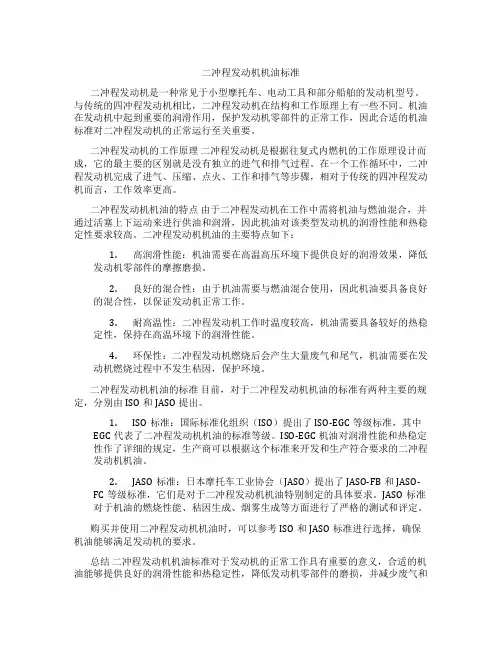
二冲程发动机机油标准二冲程发动机是一种常见于小型摩托车、电动工具和部分船舶的发动机型号。
与传统的四冲程发动机相比,二冲程发动机在结构和工作原理上有一些不同。
机油在发动机中起到重要的润滑作用,保护发动机零部件的正常工作,因此合适的机油标准对二冲程发动机的正常运行至关重要。
二冲程发动机的工作原理二冲程发动机是根据往复式内燃机的工作原理设计而成,它的最主要的区别就是没有独立的进气和排气过程。
在一个工作循环中,二冲程发动机完成了进气、压缩、点火、工作和排气等步骤,相对于传统的四冲程发动机而言,工作效率更高。
二冲程发动机机油的特点由于二冲程发动机在工作中需将机油与燃油混合,并通过活塞上下运动来进行供油和润滑,因此机油对该类型发动机的润滑性能和热稳定性要求较高。
二冲程发动机机油的主要特点如下:1.高润滑性能:机油需要在高温高压环境下提供良好的润滑效果,降低发动机零部件的摩擦磨损。
2.良好的混合性:由于机油需要与燃油混合使用,因此机油要具备良好的混合性,以保证发动机正常工作。
3.耐高温性:二冲程发动机工作时温度较高,机油需要具备较好的热稳定性,保持在高温环境下的润滑性能。
4.环保性:二冲程发动机燃烧后会产生大量废气和尾气,机油需要在发动机燃烧过程中不发生秸因,保护环境。
二冲程发动机机油的标准目前,对于二冲程发动机机油的标准有两种主要的规定,分别由ISO和JASO提出。
1.ISO标准:国际标准化组织(ISO)提出了ISO-EGC等级标准,其中EGC代表了二冲程发动机机油的标准等级。
ISO-EGC机油对润滑性能和热稳定性作了详细的规定,生产商可以根据这个标准来开发和生产符合要求的二冲程发动机机油。
2.JASO标准:日本摩托车工业协会(JASO)提出了JASO-FB和JASO-FC等级标准,它们是对于二冲程发动机机油特别制定的具体要求。
JASO标准对于机油的燃烧性能、秸因生成、烟雾生成等方面进行了严格的测试和评定。
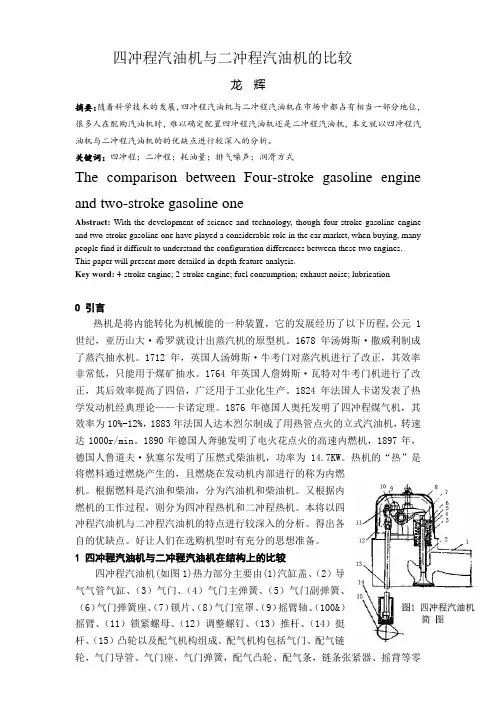
四冲程汽油机与二冲程汽油机的比较龙辉摘要:随着科学技术的发展,四冲程汽油机与二冲程汽油机在市场中都占有相当一部分地位,很多人在配购汽油机时,难以确定配置四冲程汽油机还是二冲程汽油机,本文就以四冲程汽油机与二冲程汽油机的的优缺点进行较深入的分析。
关键词:四冲程;二冲程;耗油量;排气噪声;润滑方式The comparison between Four-stroke gasoline engine and two-stroke gasoline oneAbstract:With the development of science and technology, though four-stroke gasoline engine and two-stroke gasoline one have played a considerable role in the car market, when buying, many people find it difficult to understand the configuration differences between these two engines.This paper will present more detailed in-depth feature analysis.Key word: 4-stroke engine; 2-stroke engine; fuel consumption; exhaust noise; lubrication0 引言热机是将内能转化为机械能的一种装置,它的发展经历了以下历程,公元1世纪,亚历山大·希罗就设计出蒸汽机的原型机。
1678年汤姆斯·撒威利制成了蒸汽抽水机。
1712年,英国人汤姆斯·牛考门对蒸汽机进行了改正,其效率非常低,只能用于煤矿抽水。
1764年英国人詹姆斯·瓦特对牛考门机进行了改正,其后效率提高了四倍,广泛用于工业化生产。
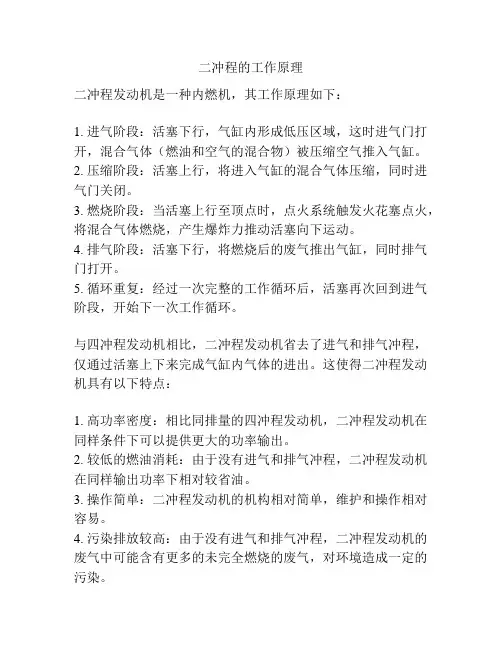
二冲程的工作原理
二冲程发动机是一种内燃机,其工作原理如下:
1. 进气阶段:活塞下行,气缸内形成低压区域,这时进气门打开,混合气体(燃油和空气的混合物)被压缩空气推入气缸。
2. 压缩阶段:活塞上行,将进入气缸的混合气体压缩,同时进气门关闭。
3. 燃烧阶段:当活塞上行至顶点时,点火系统触发火花塞点火,将混合气体燃烧,产生爆炸力推动活塞向下运动。
4. 排气阶段:活塞下行,将燃烧后的废气推出气缸,同时排气门打开。
5. 循环重复:经过一次完整的工作循环后,活塞再次回到进气阶段,开始下一次工作循环。
与四冲程发动机相比,二冲程发动机省去了进气和排气冲程,仅通过活塞上下来完成气缸内气体的进出。
这使得二冲程发动机具有以下特点:
1. 高功率密度:相比同排量的四冲程发动机,二冲程发动机在同样条件下可以提供更大的功率输出。
2. 较低的燃油消耗:由于没有进气和排气冲程,二冲程发动机在同样输出功率下相对较省油。
3. 操作简单:二冲程发动机的机构相对简单,维护和操作相对容易。
4. 污染排放较高:由于没有进气和排气冲程,二冲程发动机的废气中可能含有更多的未完全燃烧的废气,对环境造成一定的污染。
5. 润滑问题:由于运转过程中需要同时进行进气、排气、冷却和润滑,对发动机润滑系统有较高的要求。
需要注意的是,为了解决二冲程发动机的排气和润滑问题,现代的二冲程发动机通常都会增加一些特殊设计,例如利用增压装置来改善进气效果,增加油封和喷油系统来改善润滑等。
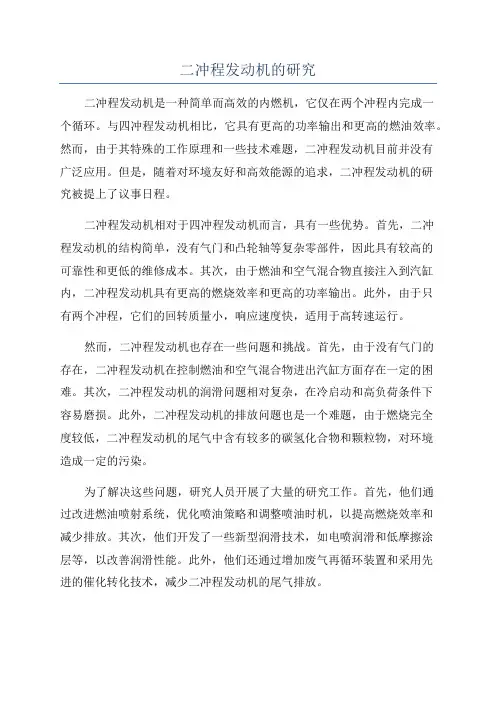
二冲程发动机的研究二冲程发动机是一种简单而高效的内燃机,它仅在两个冲程内完成一个循环。
与四冲程发动机相比,它具有更高的功率输出和更高的燃油效率。
然而,由于其特殊的工作原理和一些技术难题,二冲程发动机目前并没有广泛应用。
但是,随着对环境友好和高效能源的追求,二冲程发动机的研究被提上了议事日程。
二冲程发动机相对于四冲程发动机而言,具有一些优势。
首先,二冲程发动机的结构简单,没有气门和凸轮轴等复杂零部件,因此具有较高的可靠性和更低的维修成本。
其次,由于燃油和空气混合物直接注入到汽缸内,二冲程发动机具有更高的燃烧效率和更高的功率输出。
此外,由于只有两个冲程,它们的回转质量小,响应速度快,适用于高转速运行。
然而,二冲程发动机也存在一些问题和挑战。
首先,由于没有气门的存在,二冲程发动机在控制燃油和空气混合物进出汽缸方面存在一定的困难。
其次,二冲程发动机的润滑问题相对复杂,在冷启动和高负荷条件下容易磨损。
此外,二冲程发动机的排放问题也是一个难题,由于燃烧完全度较低,二冲程发动机的尾气中含有较多的碳氢化合物和颗粒物,对环境造成一定的污染。
为了解决这些问题,研究人员开展了大量的研究工作。
首先,他们通过改进燃油喷射系统,优化喷油策略和调整喷油时机,以提高燃烧效率和减少排放。
其次,他们开发了一些新型润滑技术,如电喷润滑和低摩擦涂层等,以改善润滑性能。
此外,他们还通过增加废气再循环装置和采用先进的催化转化技术,减少二冲程发动机的尾气排放。
近年来,一些研究机构和汽车制造商也投入了大量资源进行二冲程发动机的研究和开发。
其中一项突破性的技术是直喷和涡轮增压的组合应用。
由于直喷技术可以更精确地控制燃油喷射和混合气的浓度,而涡轮增压技术可以提高功率输出和燃烧效率,这种组合可以极大地改善二冲程发动机的性能和排放水平。
总的来说,二冲程发动机作为一种简单而高效的内燃机,具有广阔的应用前景。
通过持续的研究和创新,相信二冲程发动机可以在未来实现更高的燃油效率和更低的尾气排放,为环境保护和可持续发展做出贡献。
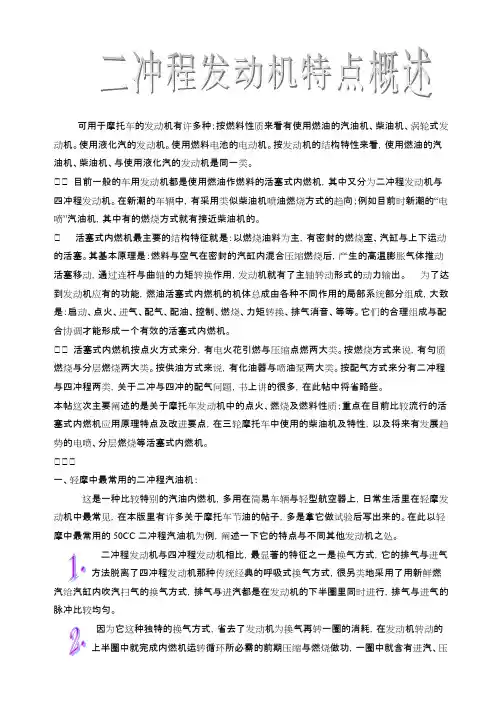
可用于摩托车的发动机有许多种;按燃料性质来看有使用燃油的汽油机、柴油机、涡轮式发动机。
使用液化汽的发动机。
使用燃料电池的电动机。
按发动机的结构特性来看,使用燃油的汽油机、柴油机、与使用液化汽的发动机是同一类。
目前一般的车用发动机都是使用燃油作燃料的活塞式内燃机,其中又分为二冲程发动机与四冲程发动机。
在新潮的车辆中,有采用类似柴油机喷油燃烧方式的趋向;例如目前时新潮的“电喷”汽油机,其中有的燃烧方式就有接近柴油机的。
活塞式内燃机最主要的结构特征就是:以燃烧油料为主,有密封的燃烧室、汽缸与上下运动的活塞。
其基本原理是:燃料与空气在密封的汽缸内混合压缩燃烧后,产生的高温膨胀气体推动活塞移动,通过连杆与曲轴的力矩转换作用,发动机就有了主轴转动形式的动力输出。
为了达到发动机应有的功能,燃油活塞式内燃机的机体总成由各种不同作用的局部系统部分组成,大致是:启动、点火、进气、配气、配油、控制、燃烧、力矩转换、排气消音、等等。
它们的合理组成与配合协调才能形成一个有效的活塞式内燃机。
活塞式内燃机按点火方式来分,有电火花引燃与压缩点燃两大类。
按燃烧方式来说,有匀质燃烧与分层燃烧两大类。
按供油方式来说,有化油器与喷油泵两大类。
按配气方式来分有二冲程与四冲程两类,关于二冲与四冲的配气问题,书上讲的很多,在此帖中将省略些。
本帖这次主要阐述的是关于摩托车发动机中的点火、燃烧及燃料性质;重点在目前比较流行的活塞式内燃机应用原理特点及改进要点,在三轮摩托车中使用的柴油机及特性,以及将来有发展趋势的电喷、分层燃烧等活塞式内燃机。
一、轻摩中最常用的二冲程汽油机:这是一种比较特别的汽油内燃机,多用在简易车辆与轻型航空器上,日常生活里在轻摩发动机中最常见,在本版里有许多关于摩托车节油的帖子,多是拿它做试验后写出来的。
在此以轻摩中最常用的50CC二冲程汽油机为例,阐述一下它的特点与不同其他发动机之处。
二冲程发动机与四冲程发动机相比,最显著的特征之一是换气方式,它的排气与进气方法脱离了四冲程发动机那种传统经典的呼吸式换气方式,很另类地采用了用新鲜燃汽给汽缸内吹汽扫气的换气方式,排气与进汽都是在发动机的下半圈里同时进行,排气与进气的脉冲比较均匀。
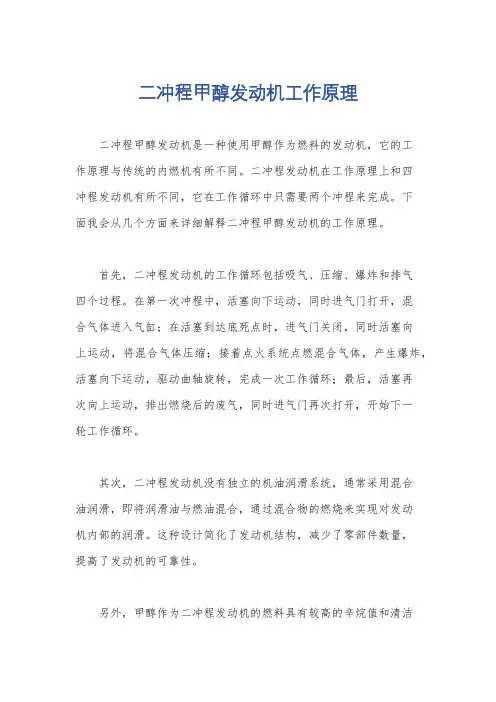
二冲程甲醇发动机工作原理
二冲程甲醇发动机是一种使用甲醇作为燃料的发动机,它的工
作原理与传统的内燃机有所不同。
二冲程发动机在工作原理上和四
冲程发动机有所不同,它在工作循环中只需要两个冲程来完成。
下
面我会从几个方面来详细解释二冲程甲醇发动机的工作原理。
首先,二冲程发动机的工作循环包括吸气、压缩、爆炸和排气
四个过程。
在第一次冲程中,活塞向下运动,同时进气门打开,混
合气体进入气缸;在活塞到达底死点时,进气门关闭,同时活塞向
上运动,将混合气体压缩;接着点火系统点燃混合气体,产生爆炸,活塞向下运动,驱动曲轴旋转,完成一次工作循环;最后,活塞再
次向上运动,排出燃烧后的废气,同时进气门再次打开,开始下一
轮工作循环。
其次,二冲程发动机没有独立的机油润滑系统,通常采用混合
油润滑,即将润滑油与燃油混合,通过混合物的燃烧来实现对发动
机内部的润滑。
这种设计简化了发动机结构,减少了零部件数量,
提高了发动机的可靠性。
另外,甲醇作为二冲程发动机的燃料具有较高的辛烷值和清洁
燃烧的特性,燃烧后产生的废气中的有害物质排放量较低,有利于
环境保护。
总的来说,二冲程甲醇发动机通过简化结构、采用混合油润滑
和利用甲醇清洁燃烧的特性,实现了高效、可靠和环保的工作原理。
这种发动机在一些特定的应用场合具有一定的优势,但也存在着一
些挑战,例如在控制混合气体进出和废气排放方面需要更加精细的
工程设计和技术支持。
希望这样的回答能够满足你的需求。
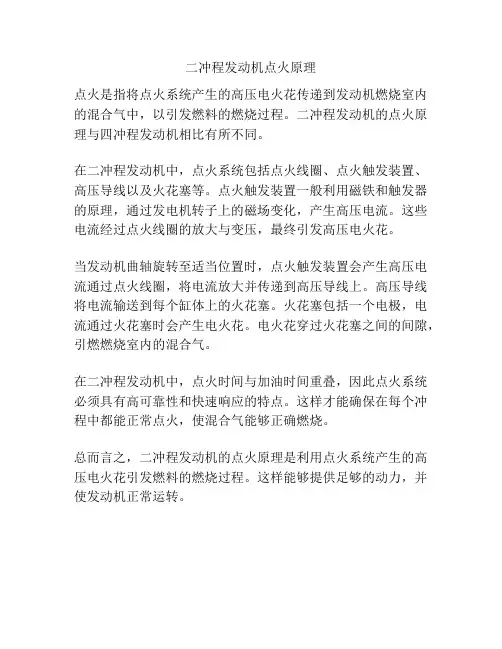
二冲程发动机点火原理
点火是指将点火系统产生的高压电火花传递到发动机燃烧室内的混合气中,以引发燃料的燃烧过程。
二冲程发动机的点火原理与四冲程发动机相比有所不同。
在二冲程发动机中,点火系统包括点火线圈、点火触发装置、高压导线以及火花塞等。
点火触发装置一般利用磁铁和触发器的原理,通过发电机转子上的磁场变化,产生高压电流。
这些电流经过点火线圈的放大与变压,最终引发高压电火花。
当发动机曲轴旋转至适当位置时,点火触发装置会产生高压电流通过点火线圈,将电流放大并传递到高压导线上。
高压导线将电流输送到每个缸体上的火花塞。
火花塞包括一个电极,电流通过火花塞时会产生电火花。
电火花穿过火花塞之间的间隙,引燃燃烧室内的混合气。
在二冲程发动机中,点火时间与加油时间重叠,因此点火系统必须具有高可靠性和快速响应的特点。
这样才能确保在每个冲程中都能正常点火,使混合气能够正确燃烧。
总而言之,二冲程发动机的点火原理是利用点火系统产生的高压电火花引发燃料的燃烧过程。
这样能够提供足够的动力,并使发动机正常运转。
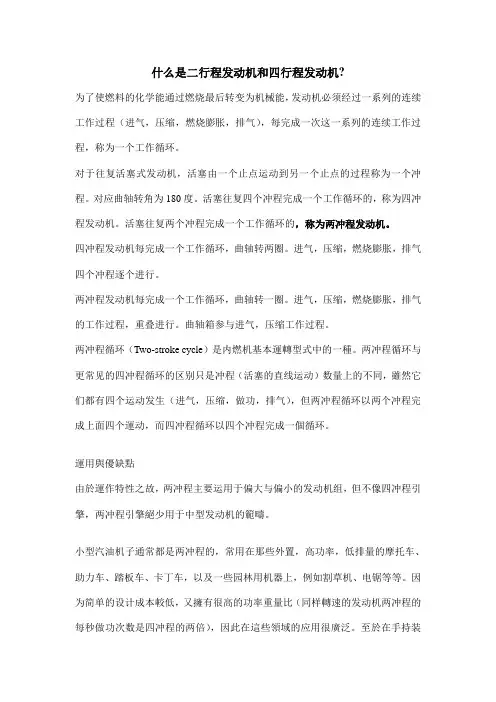
什么是二行程发动机和四行程发动机?为了使燃料的化学能通过燃烧最后转变为机械能,发动机必须经过一系列的连续工作过程(进气,压缩,燃烧膨胀,排气),每完成一次这一系列的连续工作过程,称为一个工作循环。
对于往复活塞式发动机,活塞由一个止点运动到另一个止点的过程称为一个冲程。
对应曲轴转角为180度。
活塞往复四个冲程完成一个工作循环的,称为四冲程发动机。
活塞往复两个冲程完成一个工作循环的,称为两冲程发动机。
四冲程发动机每完成一个工作循环,曲轴转两圈。
进气,压缩,燃烧膨胀,排气四个冲程逐个进行。
两冲程发动机每完成一个工作循环,曲轴转一圈。
进气,压缩,燃烧膨胀,排气的工作过程,重叠进行。
曲轴箱参与进气,压缩工作过程。
两冲程循环(Two-stroke cycle)是内燃机基本運轉型式中的一種。
两冲程循环与更常见的四冲程循环的区别只是冲程(活塞的直线运动)数量上的不同,雖然它们都有四个运动发生(进气,压缩,做功,排气),但两冲程循环以两个冲程完成上面四个運动,而四冲程循环以四个冲程完成一個循环。
運用與優缺點由於運作特性之故,两冲程主要运用于偏大与偏小的发动机组,但不像四冲程引擎,两冲程引擎絕少用于中型发动机的範疇。
小型汽油机子通常都是两冲程的,常用在那些外置,高功率,低排量的摩托车、助力车、踏板车、卡丁车,以及一些园林用机器上,例如割草机、电锯等等。
因为简单的设计成本較低,又擁有很高的功率重量比(同样轉速的发动机两冲程的每秒做功次数是四冲程的两倍),因此在這些領域的应用很廣泛。
至於在手持装置領域的應用上,两冲程循环的動力裝置由於不需倚靠重力低落原理運作的機油儲槽(oil reservoir,視需求有盤狀、壺狀等多種設計),因此在操作時不用考慮方向問題,而較適合需求。
二冲程循环的最大缺點,是由於进气跟排气要在同時進行,廢氣中有可能會含有未燃燒的燃料,造成浪費燃油及空氣污染。
除此之外两冲程循环的動力系統是倚靠額外添加的噴合油或預混潤滑油(事實上就是已經混合好適當潤滑油後一起銷售的两冲程專用燃料)來進行发动机機件的潤滑,由於這類潤滑物質通常都比較難完全燃燒,因此也容易產生較嚴重的廢氣污染。
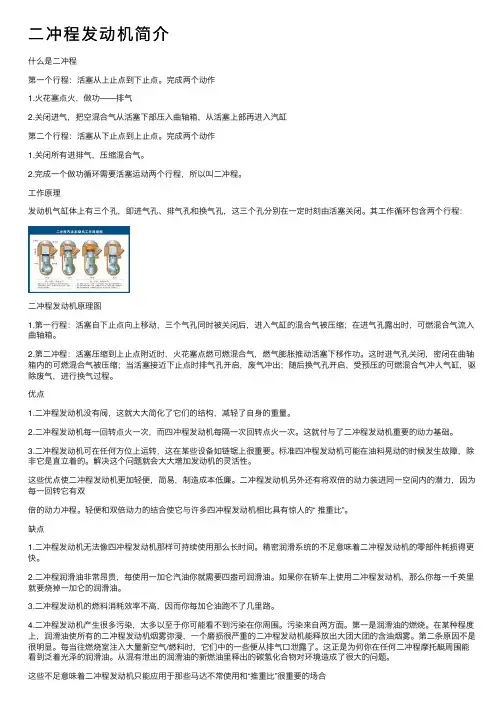
⼆冲程发动机简介什么是⼆冲程第⼀个⾏程:活塞从上⽌点到下⽌点。
完成两个动作1.⽕花塞点⽕,做功——排⽓2.关闭进⽓,把空混合⽓从活塞下部压⼊曲轴箱,从活塞上部再进⼊汽缸第⼆个⾏程:活塞从下⽌点到上⽌点。
完成两个动作1.关闭所有进排⽓,压缩混合⽓。
2.完成⼀个做功循环需要活塞运动两个⾏程,所以叫⼆冲程。
⼯作原理发动机⽓缸体上有三个孔,即进⽓孔、排⽓孔和换⽓孔,这三个孔分别在⼀定时刻由活塞关闭。
其⼯作循环包含两个⾏程:⼆冲程发动机原理图1.第⼀⾏程:活塞⾃下⽌点向上移动,三个⽓孔同时被关闭后,进⼊⽓缸的混合⽓被压缩;在进⽓孔露出时,可燃混合⽓流⼊曲轴箱。
2.第⼆冲程:活塞压缩到上⽌点附近时,⽕花塞点燃可燃混合⽓,燃⽓膨胀推动活塞下移作功。
这时进⽓孔关闭,密闭在曲轴箱内的可燃混合⽓被压缩;当活塞接近下⽌点时排⽓孔开启,废⽓冲出;随后换⽓孔开启,受预压的可燃混合⽓冲⼈⽓缸,驱除废⽓,进⾏换⽓过程。
优点1.⼆冲程发动机没有阀,这就⼤⼤简化了它们的结构,减轻了⾃⾝的重量。
2.⼆冲程发动机每⼀回转点⽕⼀次,⽽四冲程发动机每隔⼀次回转点⽕⼀次。
这就付与了⼆冲程发动机重要的动⼒基础。
3.⼆冲程发动机可在任何⽅位上运转,这在某些设备如链锯上很重要。
标准四冲程发动机可能在油料晃动的时候发⽣故障,除⾮它是直⽴着的。
解决这个问题就会⼤⼤增加发动机的灵活性。
这些优点使⼆冲程发动机更加轻便,简易,制造成本低廉。
⼆冲程发动机另外还有将双倍的动⼒装进同⼀空间内的潜⼒,因为每⼀回转它有双倍的动⼒冲程。
轻便和双倍动⼒的结合使它与许多四冲程发动机相⽐具有惊⼈的“ 推重⽐”。
缺点1.⼆冲程发动机⽆法像四冲程发动机那样可持续使⽤那么长时间。
精密润滑系统的不⾜意味着⼆冲程发动机的零部件耗损得更快。
2.⼆冲程润滑油⾮常昂贵,每使⽤⼀加仑汽油你就需要四盎司润滑油。
如果你在轿车上使⽤⼆冲程发动机,那么你每⼀千英⾥就要烧掉⼀加仑的润滑油。
3.⼆冲程发动机的燃料消耗效率不⾼,因⽽你每加仑油跑不了⼏⾥路。
为什么二冲程摩托车不能使用四冲程机油由于部分二冲程摩托车主缺乏维护保养方面的专业知识,在加注机油时较为随意,经常用四冲程机油代替二冲程机油,因此而造成了二冲程摩托车排出的烟雾过浓,燃烧室积炭严重,</PRE><PRE>启动困难,动力不足,甚至产生拉缸等一系列故障。
为什么四冲程机油不能用于二冲程摩托车呢?本文就此问题和大家一起进行探讨。
</PRE><PRE> 众所周知,二冲程摩托车的润滑方式与四冲程摩托车相比截然不同。
对二冲程车而言,由于其结构上的差异,它不能象四冲程车那样实现其关键部位的压力润滑和机油的循环使用,而</PRE><PRE>只能以下列两种方式进行润滑:</PRE><PRE> 1、预混合润滑法:将机油按一定比例预先掺入燃料油中,并充分搅拌,依靠混合在燃料中的机油润滑发动机内的摩擦表面(如嘉陵CJ50型。
轻骑15轻便摩托车等车型)。
</PRE><PRE> 2、分离润滑法:将燃料和机油分别装在两个机油箱内,通过机油泵将机油压送至化油器的柱塞腔内与燃料空气混合后进入曲轴箱,其润滑油流量由油门开度来控制(如:雅马哈MA50、</PRE><PRE> 本田TACT50、重庆CY80、春兰CL50QT等车型)由于分离润滑法采用定量供应,机油消耗量较少,只是预混合法耗量的1/3,不但能提高燃烧率,减少积炭和废气中的有害气体,还</PRE><PRE> 能使摩擦表面充分润滑,目前已被广泛采用。
不言而喻,预混合润滑法陈旧落后,现已基本被淘汰。
</PRE><PRE>二冲程与四冲程摩托车发动机的润滑特点及差异如下:</PRE><PRE> 1、发动机一旦启动,机油即与燃料一起进入气缸参与润滑,此润滑过程与环境温度无关。
船用柴油机是一种船舶上用的柴油机。
其工作原理如下:一股新鲜空气被抽进或泵进发动机汽缸内,然后被运动的活塞压缩到很高的压力。
当空气被压缩时,其温度升高以致它能点燃喷射进汽缸的细雾状燃油。
燃油的燃烧给充进的空气增加更多的热量,引起膨胀并迫使发电机活塞对曲轴做功,曲轴依次地通过其他轴来驱动传船舶的螺旋桨。
两次燃油喷射之间的运行称为一个工作循环。
在四冲程柴油发动机中,这个循环需要由活塞四个不同的冲程来完成,即吸气、压缩、膨胀和排气。
如果我们把吸气和排气与压缩和膨胀结合起来,四冲程发动机就变成了两冲程发电机。
二冲程循环开始于活塞从其冲程的底部(既下止点)上升,此时汽缸边上进气口处于打开状态。
此时,排气阀也打开,新鲜空气充入汽缸,把上一冲程残留的废气通过打开的排气阀吹出去。
阀吹出去。
当活塞向上运行到其行程上午大约五分之一时,它就关闭进气口,同时排气阀也关闭,所以温度和压力都上升到很高的值。
当活塞到达其冲程的顶部(即上止点)时,燃油阀把细雾状的燃油喷射到汽缸内的高温空气中,燃油立即燃烧,热量使压力很快上升。
这样,膨胀的燃气迫使活塞在做功冲程中向下移动。
当活塞向下移动到行程的一半过一点的地方,排气阀打开,高温的燃气由于其自身的压力开始通过排气阀向外流出,该压力受助于通过进气口进入的新鲜空气。
进气口是随着活塞的进一步下行而打开的。
然后,另一循环又开始了。
在二冲程发动机里,曲轴转一圈做一次做功冲程,而四冲程发动机,需要曲轴转二圈才做一次做功冲程,这就是为什么二冲程发动机在相同的尺寸下能够做大约两倍于四冲程发动机所做功的原因。
在当前实际使用中,具有相同缸径和相同转速的发动机,二冲程发动机输出的功率比四冲程发动机高出大约百分之八十。
这种发动机功率的增加,使得二冲程发动机作为大型船舶主机而得到广泛地应用。
船用柴油机和普通柴油机的区别有两点其一,船用油一般碱值比较高。
由于船用燃油硫含量高,(一般在0.5%-3.5%范围内变化)因而要求润滑油必须有足够的碱保持性,以中和燃料燃烧后生成的酸性物质。
二、工作原理四程柴油机的主要机件1.固定机件:机座1,机体4,主轴承3,汽缸盖7,汽缸套6等。
2.运动机件:曲轴13,连杆10,活塞8,活塞销9,连杆螺栓11等。
3.配气机构:凸轮轴14,顶杆15,摇臂16,气阀机构(进气阀17、排气阀 18、气阀弹簧19)等。
4.燃油系统:喷油泵20,高压油管21,喷油器2等5.辅助机件:进气管5和排器管12等此外,对于整机而言,还有润滑,冷却,启动和控制等系统。
一些名词:1.上止点:活塞距曲轴中心最远的位置2.下止点:活塞距曲轴中心最近的位置3.活塞冲程(S):上、下止点间的距离。
4.压缩室容积(V c):活塞位于上止点时,活塞顶部与缸盖间的容积,又称燃烧室容积。
5.汽缸工作容积(V n):活塞上、下止点之间的容积称为一个汽缸的工作容积,它可以用气缸直径D(cm)由下式表示:Vn=[(Pai*D**2)/4]*S *(10**3)式中 S——活塞冲程(cm)。
6.汽缸的最大容积(V a):活塞在下止点时,气缸的容积,即气缸工作容积与压缩容积的之和:V a=V h+V c7.汽缸的总容积V,总排量:室内燃机所有汽缸工作容积的总和。
即:V=V h*I(L)式中 i——气缸数。
进气冲程:进气压力大致保持不变.为了利用气流的惯性来提高充气量,进气阀在活塞过了下止点以后才关闭.压缩冲程:进、排气阀关,活塞上行,缸内气体被迅速压缩,气压上升,同时气温升高,达到柴油的自燃温度时,柴油便自行燃烧膨胀。
作用:1.提高空气的温度,为燃料的自行发火作准备.2.为气体膨胀作功创造条件.3燃烧膨胀冲程3.作功冲程:此时进排气阀钧关闭,缸内燃料迅速燃烧膨胀,气体压力急剧上升,推动活塞自上止点往下止点运动。
最高燃烧压力Pz,压力升高比: 为燃烧压力与压缩终点压力之比.4.排气冲程.排气阀早开晚关,排气阻力的存在,比如有消声器,使排气阀必须提前打开,以减少活塞排气的阻力,而活塞在完成排气过程时,主要靠惯性.二冲程柴油机与四冲程柴油机的比较:1.在相同的气缸尺寸和转速下,二冲程发动机的功率理应比四冲程发动机增加一倍,但由于:1扫气容积的损失;2充气时间短程废气消除困难驱动扫气泵要消耗一部分功率,所以只增加了50%-70%左右2.均匀性好其他形式:按气流在气缸中流动的路线不同,(1)气孔式直流换气的柴油机(2)横流扫气的二冲程柴油机(3)回流换气的二冲程柴油机第一冲程:活塞自下而上,压缩,继续前行,进气孔开,曲轴箱形成真空度,可燃气进入曲轴箱。
二冲程的工作原理
二冲程发动机是指每个工作循环中,活塞上升和下降两个冲程完成一次供油、爆燃、排气的过程。
其工作原理如下:
1. 进气冲程:当活塞向上运动时,活塞铰上的进气孔与进气道相连,使空气燃油混合物从进气道进入活塞的上方。
此时,活塞下部的排气孔被活塞铰挡住,防止混合气体从排气孔中逸出。
2. 压缩冲程:当活塞开始向下运动时,进气孔与进气道分离,排气孔和排气道相连,将残留的废气排出。
同时,活塞上方已经加满混合气体,开始压缩。
3. 爆燃冲程:当压缩到一定程度时,点火系统触发火花塞发出火花,点燃混合气体。
燃烧产生的爆炸力将活塞推向下方,驱动活塞运动。
4. 排气冲程:当活塞再次向上运动时,进气孔与进气道分离,排气孔与排气道相连,将燃烧后的废气排出。
与此同时,燃烧室重新充满混合气体,为下一个循环做准备。
二冲程发动机的工作原理相较于四冲程发动机较为简单,没有独立的气门控制系统和润滑系统。
它具有结构简单、重量轻、功率强的特点,但由于工作过程没有爆炸前排放废气的过程,二冲程发动机的排放物质较多,燃油消耗率较高,短期内难以满足环保要求。
二冲程发动机与四冲程发动机(Two stroke engine and four strokeengine)What is the difference between two stroke engine and four stroke engine?Working principle is different, regardless of the two stroke engine or four stroke diesel engine, through the intake, compression, combustion, expansion, exhaust four working processes, in order to complete a work cycle.What's different is that:1, in the four stroke engine, the crankshaft rotates two times, the piston reciprocating movement two times, every four strokes to complete a work cycle. In the two stroke diesel engine, the crankshaft rotates every time, and the piston moves once and again, and completes a working cycle every two strokes.2, two stroke diesel engine and four stroke diesel engine, each completed a working cycle, its inlet, exhaust valve or inlet, exhaust, scavenging port is only opened and closed once, but its opening and closing time cycle is different.3. Theoretically, the power generated by a two stroke diesel engine should be equal to two times the power generated by the four stroke diesel engine of the same working volume.4. Because of the two stroke diesel engine ventilation, a part of the combustible mixture exhaust with exhaust gas, so the fuel and lubricating oil consumption are large.5, because the two stroke engine work stroke frequency is large, so the work is relatively smooth.The difference of general arrangementThe 1 and four stroke engines have a complex valve train valve mechanism, which is controlled by the camshaft to open and close the valve timing to complete the intake and exhaust process. The two stroke diesel engine uses the piston to control the opening of the exhaust port and the scavenging port to complete the scavenging and exhausting process.The scavenging and exhaust of the 2 and two stroke engines are carried out near the lower dead center of the piston. The valve train of the four stroke engine is set on the cylinder head.Most of the 3 and two stroke diesel engines use crankcase scavenging, and the four stroke engine crankcase has a pressure oil duct or tubing.The cylinder head of 4 and two stroke engines has simple structure, no inlet, exhaust port and valve train, and no lubricating oil duct. The cylinder head of a four stroke engine is a very complex part.The piston rings of the 5 and two stroke engines only have gas rings and no oil rings. The piston ring of the four stroke engine has both gas ring and oil ring.The piston skirt of the 6 and two stroke engines should be longerthan the piston skirt of the four stroke engineWorking principle of two stroke diesel engineBy two strokes of the piston to complete a working cycle of the engine is called the two stroke diesel engine, oil engine crankshaft in a work cycle of only one round, compared with the four stroke diesel engine, it improves the work ability, there are great differences in the structure and working principle.The basic structure of the two stroke diesel engine is the same as that of the four stroke diesel engine, and the main difference is the valve train. Two redThe diesel engine has no inlet valve, and some of the exhaust valves are not available, but the lower part of the cylinder is provided with a scavenging port and an exhaust port;A scavenging port and an exhaust valve mechanism are also provided. Specially, a scavenging pump driven by moving parts and a storage pressure air are specially set upThe gas scavenging box is used to match the piston and the air port, thus simplifying the structure of the diesel engine.Diagram is the working principle diagram of two stroke diesel engine. The scavenging pump is attached to the side of the diesel engineThe rotor is driven by a diesel engine. Air is inhaled from the pump, compressed and discharged, stored in a larger volumeIn the scavenging chamber, a certain pressure is maintained in the scavenging chamber. The work of the two stroke diesel engine is illustrated in this paperPrinciple.Combustion expansion and exhaust stroke:The fuel is ignited and burned in the combustion chamber to produce high temperature and high pressure gas. The piston is driven by the gas from the TDCDownward movement, external work. The piston goes down until the exhaust port opens (at this point the crank is at the point where the gas is fired)The end of the expansion work, a large number of exhaust gas in the cylinder by their own high pressure free exhaust, exhaust from the exhaust port to the exhaust pipe.When the pressure in the cylinder drops close to the scavenging pressure (the scavenging pressure in the scavenge box is 012, the downward piston to open the scavenging port 3 (at this time the crank at the point 4 position, scavenging air into the cylinder,Meanwhile, the exhaust gas from the cylinder is driven out of the cylinder through the exhaust port. The piston runs to the lower dead end, the end of the stroke, but scavengingThe process continues until the next stroke, and the exhaust port closes (at this point the crank is at the point.Schematic diagram of working principle of two stroke diesel engine for overhaul of marine diesel engine third 4 342Scavenging and compression stroke:The piston moves upward from the lower dead point, and the piston is supplied by the scavenging pump before scavenging the air portThe air in the cylinder enters the cylinder through the scavenging port, and the residual gas in the cylinder is entered into the air of the cylinder through the exhaust portSwept cylinder. The piston continues upward, gradually covering the scavenging port, when the scavenging port is completely closed (at this time the crank is at the point)Position, air stop filling, exhaust is still in progress, this stage is called "after exhaust stage."". When the exhaust port closesThe air in the cylinder begins to compress at the point where the crank is at the point. When the front point of the compression is uppermost,The injector sprays fuel into the cylinder, mixes with the high temperature and high pressure air, and then fires near the TDCFire combustion. The stroke ends and forms a complete working cycle with the previous stroke.The indicator diagram of the two stroke diesel engine is shown in figure, which is the starting point of the injection and the TDC of the pistonBurning end point.Compared with four stroke diesel engine, two stroke diesel engine has some obvious advantages, of course, there are inherentShortcoming.The working principle of 2 and four stroke diesel enginesThe work of the diesel engine is accomplished by four processes: intake, compression, combustion, expansion and exhaust. These four processes form a working cycle. The piston takes four processes to complete a working cycle of a diesel engine called a four stroke diesel engine. Now compare the animation above to explain how it works.I. intake strokeThe first stroke - air intake, the task is to make the cylinder filled with fresh air. When the intake stroke starts, the piston is at the top dead center, and there are some exhaust gases in the combustion chamber of the cylinder.When the crankshaft rotates the elbow, the connecting rod moves the piston from the TDC to the TDC, and the intake valve opens with the transmission mechanism associated with the crankshaft.With the downward movement of the piston, the volume of the piston in the cylinder increases gradually: the air pressure in the cylinder is lower than the pressure in the intake pipe, so the outside air is constantly filled into the cylinder.The gas pressure in the cylinder varies with the volume of the cylinder as shown in the animation during the intake process. The ordinate in the figure represents the gas pressure P, and the abscissa represents the cylinder volume Vh (or the piston S), which is called the indicator diagram. The pressure curve in the diagram shows the variation law of the gas pressure in the cylinder when the diesel engine is working. From the soil we can see that the initial intake, due to the existence of residual gas, so slightly higher than the atmospheric pressure P0. During the intake process because of the air through the intake pipe and the air inlet valve flow resistance, so the gas pressure below the atmospheric pressure of the intake stroke, its value is 0.085 ~ 0.095MPa, in the whole process of air, gas cylinder pressure remained approximately constant.When the piston moves down close to BDC, air into the cylinder has high speed, great inertia, in order to use the flow inertia toimprove chongqiliang intake valve closes after the piston after bdc. Although the piston up, but because of the inertia of the gas, the gas can still be filled with the cylinder.Two. Compression strokeSecond stroke compression. When the piston is compressed, the piston moves from the TDC to the bottom, and the stroke has two functions. One is to increase the temperature of the air, and the other is to prepare for the spontaneous combustion of the fuel. Two is to create conditions for the expansion of the gas. When the piston, after the intake valve closes, the air in the cylinder is compressed, with small volume, air pressure and temperature is rising, the compression end point pressure and humidity and air compression degree, and compression ratio, the general compression end point pressure and temperature is: Pc = 4 8MPa, Tc = 750 ~ 950K.The spontaneous combustion temperature of the diesel fuel is about 543 - 563K, and the temperature at the compression end is much higher than that of the diesel engine.Diesel injected into cylinder,Not immediately angry, and after physical and chemical changes after the fire, this period of about 0.001 to 0.005 seconds, known as the ignition delay period. Therefore, in turn the crank first stopping point before 10 ~ 35 degree crank angle at the start of the fuel atomization spray into the cylinder, and the crank end point after 5 ~ 10 degrees on, the highest combustion pressure in the combustion chamber, the piston downward force.Three. Combustion expansion strokeThird stroke combustion expansion. At the beginning of the stroke, most of the fuel injected into the combustion chamber is burning. During combustion, a large amount of heat is released, so the pressure and temperature of the gas increase rapidly. The piston moves downward under the action of high temperature and high pressure gas, and rotates the crankshaft through the stalk, so that the external work can be done. So this stroke is also called work or work stroke.As the piston goes down, the volume of the cylinder increases, the pressure of the gas drops, and the working stroke ends at the bottom of the piston and the opening of the exhaust valve.In animation, the pressure change of the working stroke indicates the sharp rise of the pressure when the fuel burns in the cylinder. The highest point indicates the maximum combustion pressure Pz, and the pressure and temperature of the point are the same:Pz = 6 ~ 15MPa, Tz = 1800 ~ 2200KThe ratio of the maximum combustion pressure to the pressure at the end of compression (Pz / Pc) is called the ratio of pressure rise at combustion, and is expressed by lambda. According to the type of diesel engine, the range of the lambda value is as follows: lambda = Pz / Pc = 1.2 - 2.5.Four. Exhaust strokeFourth stroke exhaust. The function of the exhaust stroke is to exhaust the exhaust gas so as to fill the fresh air andprepare for the next cycle of air intake. When the piston of the working stroke moves near the lower dead center, the exhaust valve is opened, and the piston is driven by the crankshaft and the connecting rod to move up from the lower dead point to the upper stopping point, and the exhaust gas is discharged out of the cylinder. Because there is resistance exhaust system, so in the beginning of the exhaust stroke, and gas pressure than atmospheric pressure in the cylinder of the 0.025 - 0.035MPa, the temperature of Tb = 1000 ~ 1200K. In order to reduce the resistance of the piston movement during exhaust, the exhaust valve opens before the lower dead center. When the exhaust valve is opened, the gas with a certain pressure immediately goes out of the cylinder, and the pressure in the cylinder drops rapidly. When the piston moves upwards, the exhaust gas in the cylinder is discharged by the piston. In order to make use of the exhaust airflow inertia, exhaust gas is clean, the exhaust valve is closed after the top dead point.In the animation, the exhaust stroke curve indicates that the gas pressure in the cylinder is almost constant, but slightly higher than the atmospheric pressure. The pressure Pr at the end of the exhaust stroke is about 0.105 ~ 0.115MPa, and the temperature of the residual gas is about 850 ~ 960K Pr.Because of the intake and exhaust valves are open as early as late off; so in the end of the exhaust stroke and the beginning of the intake stroke, the piston at TDC, a time of inlet and exhaust valves open at the same time, this time with the crank angle to said called valve overlap angle.After the end of the exhaust stroke, the intake stroke startsagain, so the whole working cycle is repeated according to the above process. Because the working cycle of this kind of diesel engine is completed by four piston strokes, that is, the crankshaft rotates two revolutions, so called four stroke diesel engine.In the four stroke of the four stroke diesel engine, only third strokes, that is, the working impulse, will produce power external work, while the remaining three strokes are the preparation process of the work of consumption. For this reason, the flywheel must be installed on a single cylinder diesel engine, and the crankshaft rotates continuously and evenly in four strokes with the inertia of the flywheel.。
二冲程与四冲程发动机相比较
二冲程与四冲程发动机相比较哪个更好,这个要根据不同的应用场合进行具体分析。
二冲程和四冲程发动机从目前来看,各有优劣。
下面分别介绍下二冲程发动机和四冲程发动机的特点。
二冲程发动机的特点
1.二冲程发动机没有阀,与四冲程发动机相比较,这就大大简化了它们的结构,减轻了自身的重量。
2.二冲程发动机每一回转,点火一次,而四冲程发动机每隔一次回转点火一次,这赋予了二冲程发动机重要的动力基础。
3.二冲程发动机可在任何方位上运转,这在某些设备如链锯上很重要,而标准四冲程发动机可能在油料晃动的时候发生故障,除非它是直立着的,二冲程发动机的灵活性更强。
四冲程发动机的特点
1.四冲程发动机具备精密润滑系统,与二冲程发动机相比较,其零部件耗损较慢,可持续使用时间更长
2.四冲程发动机无需配比燃油,更加无需购买昂贵的2T润滑油,减少配比操作同时降低使用成本。
3.四冲程发动机的燃油消耗率较低,更加省油。
4.四冲程发动机燃烧充分,污染较少。
两冲程发动机产生的污染,主要来自两方面:
第一,2T润滑油的燃烧,在某种程度上,润滑油使所有的二冲程发动机烟雾弥漫,一个磨损很严重的二冲程发动机能释放出大团大团的含油烟雾。
第二,每当往燃烧室注入大量新空气/燃料时,其中的一些会从排气口泄露。
例如,在任何二冲程摩托艇周围能看到泛着光泽的润滑油,这会对环境造成很大的污染。
——奥斯顿园林机械。